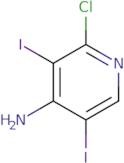2-Chloro-3,5-diiodo-4-pyridinamine
CAS: 1171919-00-8
Ref. 3D-WWB91900
| 1g | Ausgelaufen | ||
| 5g | Ausgelaufen | ||
| 10g | Ausgelaufen | ||
| 250mg | Ausgelaufen | ||
| 500mg | Ausgelaufen |
Produktinformation
- 4-Pyridinamine, 2-chloro-3,5-diiodo-
2-Chloro-3,5-diiodo-4-pyridinamine is an antimycobacterial agent that acts as an inhibitor of the enzyme mycobacterial synthetase. It has been shown to be effective against tuberculosis and various other bacterial infections. 2-Chloro-3,5-diiodo-4-pyridinamine inhibits the production of ATP by binding to the active site of the enzyme. This prevents conversion of ADP to ATP and leads to cell death. 2CLD4P has also been shown to have antibacterial activity against Staphylococcus aureus and other bacteria at concentrations below its inhibitory concentration for mycobacteria. The activity of 2CLD4P is due in part to its ability to inhibit glutamate dehydrogenase, which is involved in the metabolic pathway for bacterial growth.





